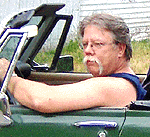1⁄35Building a Panzer IVJ - Part 1

My wash is 80% thinner and 20% burnt Umber Model Master paint. Do not spray your tank with this wash through the airbrush, do not slop the wash over the entire thing with a 2Ē brush all that would do is make a mess. Take that old brush with 7 or 8 hairs in it and use it to put the wash where you want it. Along recessed lines, weld seams, the base of raised details and the like. Do the entire kit....the turret, gun, upper and lower hull, suspension, and donít forget those wheels on the sprue. Just dip your brush in the wash and touch it to the model. The paint will run off the brush and wick around the parts your trying to pick out or along recessed panel lines and inside corners. I did use a wider brush on the treadplated areas of the fenders. Donít worry if it gets a little messy now but donít be careless either. Set it aside to dry completely. Once itís dry you can clean up if necessary with a q-tip dipped, then patted dry, with thinner. If you rub an area too much the Future will come off so be careful. At this time you can paint the rubber areas of the roadwheels charcoal black.
Drybrushing is one aspect of weathering that Iíve constantly seen overdone. I
sípose itís a matter of personal taste, I choose to drybrush subtly. I begin
with a medium drybrush with the base color-Dunkelgelb-over the entire vehicle.
This is the realism stage of drybrushing, not the artsy stage. The paint will
wear off certain parts of the vehicle that are subjected to wear exposing first
the lower colors and in the extreme the metal. Take care when drybrushing around
those tiny p.e. parts-you donít want to knock Ďem off. Drybrushing is simply
dipping your brush in the paint then wiping it across a rag or paper towel until
very little paint remains. When you then run your brush over the surface of the
model the high spots pick up the remaining pigment. Areas likely to stand out
now are edges, the raised areas of treadplate and boltheads.......
†








